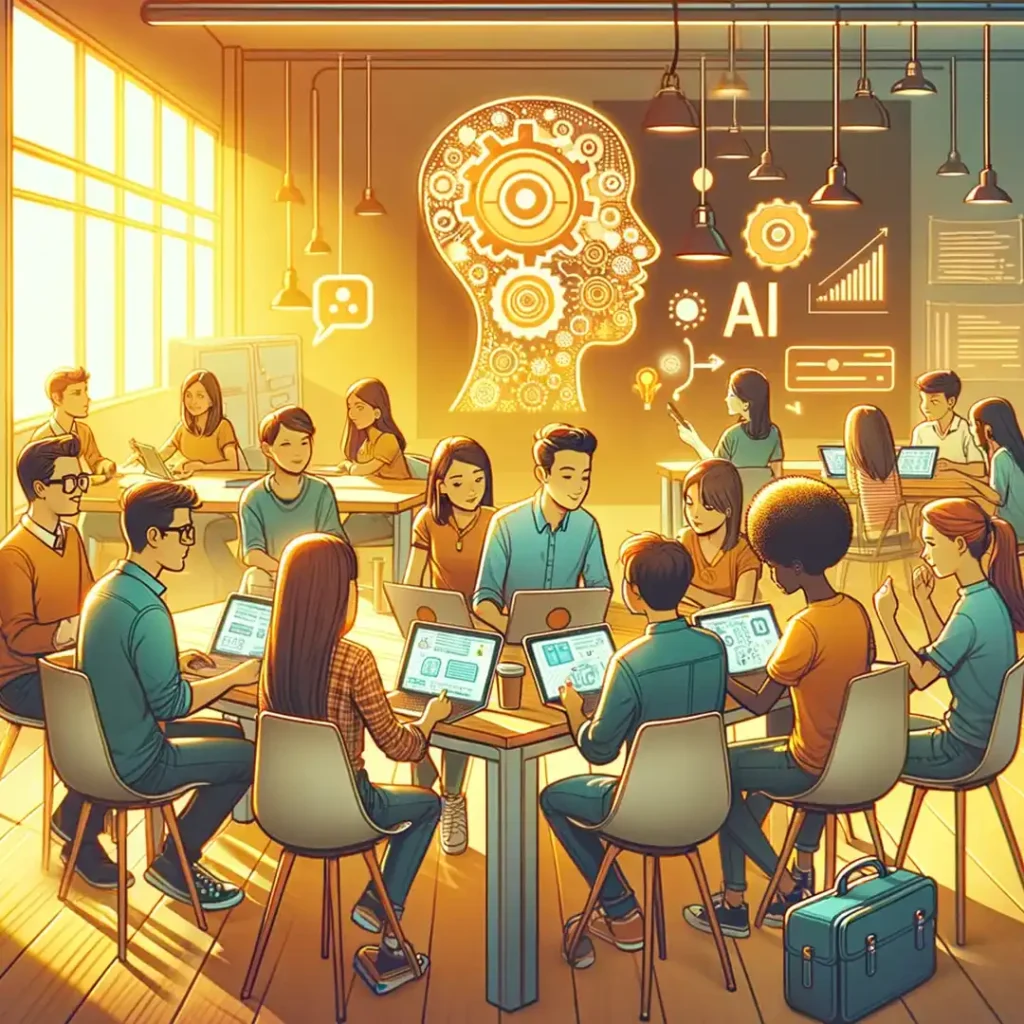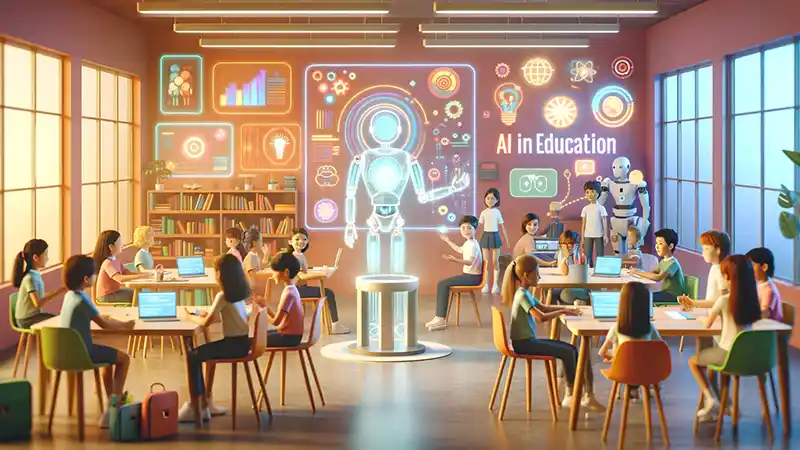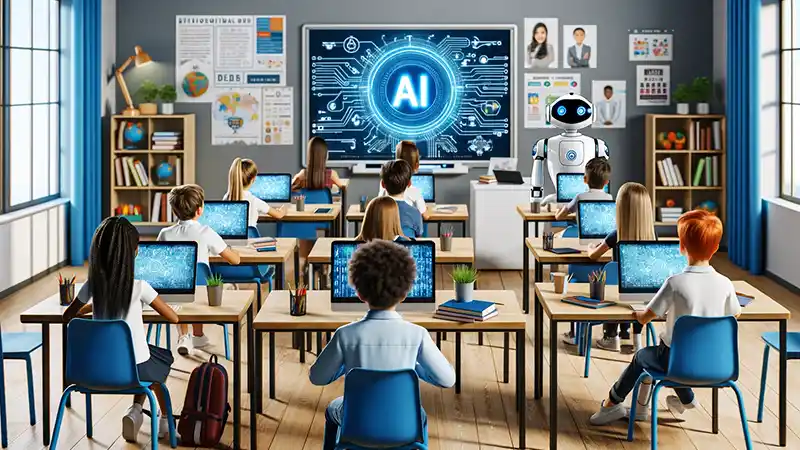Artificial Intelligence (AI) is a rapidly advancing field that is influencing many aspects of our lives, including the way we work, learn, and interact with technology. This transformation is evident across various industries, and education is no exception. As educators, it’s essential to understand AI and its implications to effectively prepare our students for a world where AI plays a significant role.
AI’s importance in education cannot be overstated. In the classroom, AI has the potential to personalize learning, making it possible to tailor educational experiences to individual student needs. This technology can provide unique insights into students’ learning patterns, helping educators better support diverse learning styles and needs.
Furthermore, as AI continues to shape various sectors, our students will enter a workforce where AI literacy is not just valuable but necessary. By integrating AI education into our teaching, we’re equipping students with the knowledge and skills they need for future success.
Looking for step-by-step instructions on how to use AI to create individual lessons? Click here!
What is Artificial Intelligence?

Artificial Intelligence, commonly known as AI, refers to the development of computer systems that can perform tasks typically requiring human intelligence. These tasks include learning, problem-solving, decision making, and understanding language.
Definition of AI
At its core, AI is about creating machines that can think and learn like humans. The ultimate goal is to develop systems that can not only process and respond to information but also adapt and improve over time.
Brief History of AI Development: The concept of AI dates back to ancient history with myths and stories of artificial beings endowed with intelligence. However, the formal field of AI as we know it began in the mid-20th century. The term “Artificial Intelligence” was first coined in 1956 by John McCarthy at the Dartmouth Conference, which is widely considered the birth of AI as an academic field. Since then, AI has evolved from simple algorithms to complex machine learning and neural network systems.
Key Concepts in AI
Machine Learning: This is a core part of AI where machines are programmed to learn from data. Machine learning enables computers to improve at tasks through experience, without being explicitly programmed for each specific task.
Neural Networks: Inspired by the human brain, neural networks are a series of algorithms that mimic the operations of a human brain to recognize relationships between vast amounts of data. They are used in deep learning, a subset of machine learning, and are key in enabling AI systems to learn and make decisions.
Natural Language Processing (NLP): This involves the ability of a computer program to understand, interpret, and respond to human language in a valuable way. NLP is what powers chatbots, virtual assistants, and other applications that interact with humans in natural language.
Understanding these concepts is vital for educators as they form the foundation upon which current and future AI technologies are built. As we delve deeper into the applications of AI in education, recognizing these key concepts will help us appreciate the potential and limitations of AI in the learning environment.
The Impact of AI in Education

The introduction of Artificial Intelligence (AI) into the educational sector has started to transform the teaching and learning landscape. This impact is evident in various applications, potential benefits, and the challenges and ethical considerations that come with integrating AI into education.
Current Applications of AI in Education
Personalized Learning: AI systems can analyze a student’s performance and tailor the educational content to suit their learning pace and style. This individualized approach helps in addressing specific strengths and weaknesses of each student.
Automated Administrative Tasks: AI can automate time-consuming administrative tasks such as grading and attendance, allowing teachers to devote more time to teaching and student interaction.
Intelligent Tutoring Systems: These AI-driven systems provide students with additional, personalized tutoring, offering feedback and guidance similar to a human tutor.
Potential Benefits for Teaching and Learning
Enhanced Engagement: AI can provide interactive and immersive learning experiences (like simulations) that can enhance student engagement and motivation.
Data-Driven Insights: Teachers can use AI to gain insights from data on student performance, helping them identify areas where students struggle and succeed, leading to more effective teaching strategies.
Accessibility: AI can help make education more accessible to students with disabilities, for instance, through voice recognition and predictive text technologies.
Challenges and Ethical Considerations
Data Privacy and Security: The use of AI in education raises concerns about the security and privacy of students’ data. It’s crucial to ensure that data is handled securely and ethically.
Bias and Fairness: AI systems can inherit biases present in their training data, which can lead to unfair or biased outcomes for students. Ensuring AI fairness and neutrality is a significant challenge.
Dependence on Technology: Over-reliance on AI tools can lead to a decrease in traditional teaching methods and human interaction, which are critical to student development.
Understanding these aspects of AI in education is crucial for educators. While AI presents exciting opportunities to enhance teaching and learning, it’s equally important to navigate the challenges and ethical considerations it brings. This balanced approach will ensure that AI is used to complement and enhance educational experiences, rather than replace the essential human elements of teaching.
AI Technologies Useful for the Classroom
The integration of Artificial Intelligence (AI) in education has led to the development of various technologies that are proving to be invaluable in the classroom. These AI-driven tools are designed to enhance both teaching and learning experiences. Let’s explore some examples of AI in action within educational settings.
AI Tutors and Assistants: AI tutors are becoming increasingly sophisticated, offering students personalized assistance outside the traditional classroom environment. These systems can provide instant feedback, help with homework, and even assist in understanding complex topics. For example, AI-powered chatbots can answer students’ queries round the clock, ensuring continuous learning support.
Personalized Learning Platforms: These platforms use AI to analyze a student’s learning habits, strengths, and weaknesses to create a customized learning plan. They adapt in real-time, adjusting the difficulty level of tasks and suggesting resources based on the learner’s progress. Such platforms cater to the individual needs of students, making learning more effective and engaging.
Content Enhancement Tools: AI is used to develop tools that can enhance educational content. This includes the creation of interactive and immersive educational experiences using augmented reality (AR) and virtual reality (VR), making learning more engaging and effective.
Language Learning Applications: AI-driven language learning apps are capable of providing personalized language learning experiences. They can assess a learner’s language proficiency, adapt the curriculum accordingly, and even offer conversational practice with AI-powered characters.
Predictive Analytics: AI systems are capable of analyzing educational data to predict student outcomes, helping educators identify students who might need additional support. This predictive capability can play a crucial role in early intervention and in tailoring teaching strategies to improve student success rates.
Automated Essay Scoring: Some AI systems can evaluate and score student essays. These systems use natural language processing to understand and grade written work, providing quick feedback to students and reducing the grading load on teachers.
These examples represent just a fraction of the potential AI holds for transforming the educational landscape. As these technologies continue to evolve, they promise to further revolutionize the way teaching and learning are conducted, making education more personalized, accessible, and efficient.
Preparing Students for an AI Future

As we stand at the brink of a new era dominated by Artificial Intelligence (AI), it’s crucial for educators to prepare students for the challenges and opportunities this AI-driven world presents. This preparation involves not only equipping them with the necessary skills but also integrating AI topics into the curriculum and fostering a mindset that encourages critical thinking about AI’s broader societal impacts.
Skills Students Need in an AI-Driven World
Digital Literacy: Understanding how to interact with AI technologies is essential. This includes basic coding skills, data literacy, and the ability to work with AI tools.
Critical Thinking and Problem-Solving: AI can provide data and predictions, but human judgment is crucial in interpreting and applying this information. Students must be skilled in critical thinking and problem-solving to navigate an AI-enhanced world effectively.
Creativity and Innovation: As AI handles more routine tasks, creativity becomes a valuable skill. Students should be encouraged to think innovatively and explore creative solutions to complex problems.
Emotional Intelligence: AI lacks the human touch, making emotional intelligence, empathy, and interpersonal skills more important than ever. These skills will be crucial in jobs that AI cannot replace.
Integrating AI Topics into the Curriculum
Incorporate Basic AI Concepts: Introduce AI concepts in subjects like mathematics, science, and computer science. This can include lessons on how AI algorithms work or the role of data in AI.
Interdisciplinary Approach: Use AI as a tool to teach other subjects. For instance, an AI-powered analytics tool can be used in a statistics class.
Project-Based Learning: Implement projects that allow students to work with AI technologies, like building simple models or using AI tools for research.
Encouraging Critical Thinking about AI and Its Societal Impacts
Ethical Considerations: Discuss the ethical implications of AI, such as privacy concerns, bias in AI algorithms, and the impact of automation on employment.
Societal Impact: Encourage students to think about how AI impacts society at large, including potential benefits and challenges.
Future Opportunities and Challenges: Discuss the future of AI and what it might mean for different industries and society, preparing students to adapt to and shape this future.
Preparing students for an AI future is not just about teaching them to use new tools; it’s about fostering a mindset that is adaptable, creative, and thoughtful about the impact of technology on society. By equipping students with these skills and insights, we’re not just preparing them for the future; we’re empowering them to play an active role in shaping it.
Conclusion
It’s clear that AI literacy is no longer a futuristic concept but a present-day necessity for educators. The integration of AI in education is not just an addition to our teaching toolkit; it’s a transformative force that’s reshaping how we teach and how students learn.
Recap of the Importance of AI Literacy for Educators
AI literacy is crucial for educators for several reasons. It equips us with the understanding and skills needed to effectively integrate AI tools into our teaching practices. It also enables us to prepare our students for a future where AI will be a significant part of their personal and professional lives. Understanding AI and its applications in education helps us to enhance learning experiences and prepare students for the challenges and opportunities of an AI-driven world.
Encouragement for Educators to Explore AI Further
I encourage all educators to continue exploring AI. This exploration can take many forms, from participating in professional development courses to experimenting with AI tools in the classroom. The field of AI is continually evolving, and staying informed about new developments and educational applications is key to being an effective, future-ready educator.
Call to Action for Embracing AI in Educational Settings
Let’s view AI as an ally in education. By embracing AI, we can unlock new potentials in personalized learning, enhance student engagement, and streamline administrative tasks, allowing us more time to focus on what we do best – teaching and inspiring students. Let’s take proactive steps to integrate AI into our curriculums, use AI as a tool for enhancing learning experiences, and prepare our students for a future in which AI will be ubiquitous.
In conclusion, the journey into AI in education is just beginning. As educators, we have the unique opportunity to shape how this technology impacts our teaching practices and our students’ learning experiences. Let’s embrace this opportunity and lead the way in harnessing the power of AI to create a more engaging, effective, and inclusive educational future.



